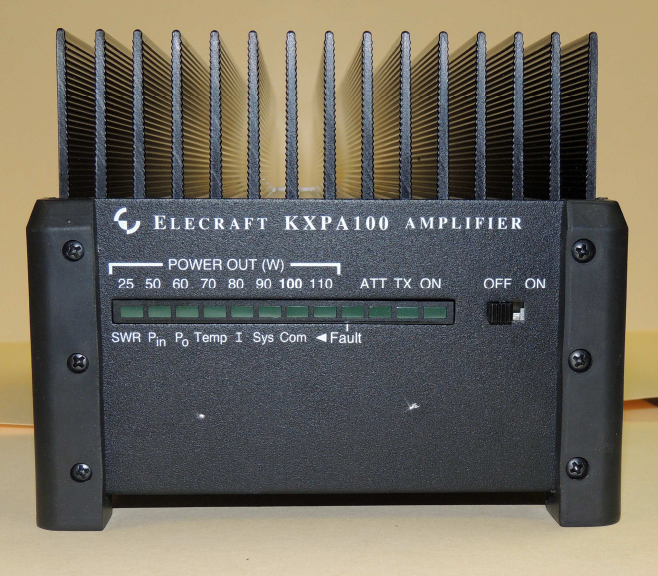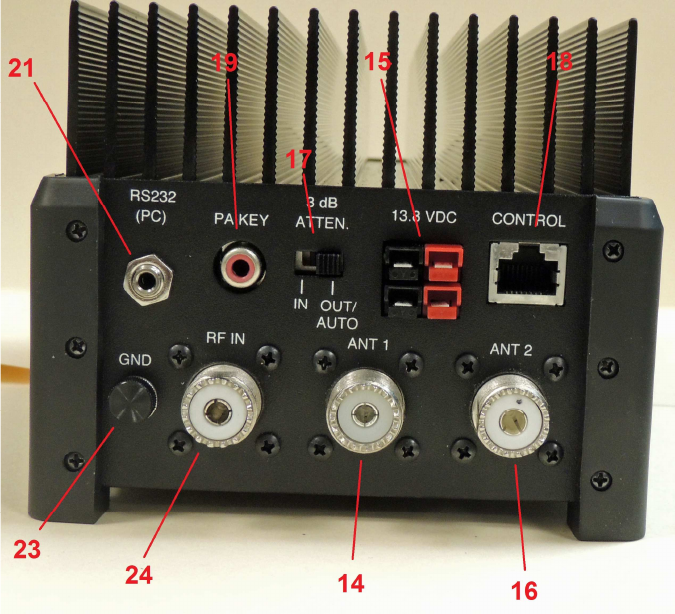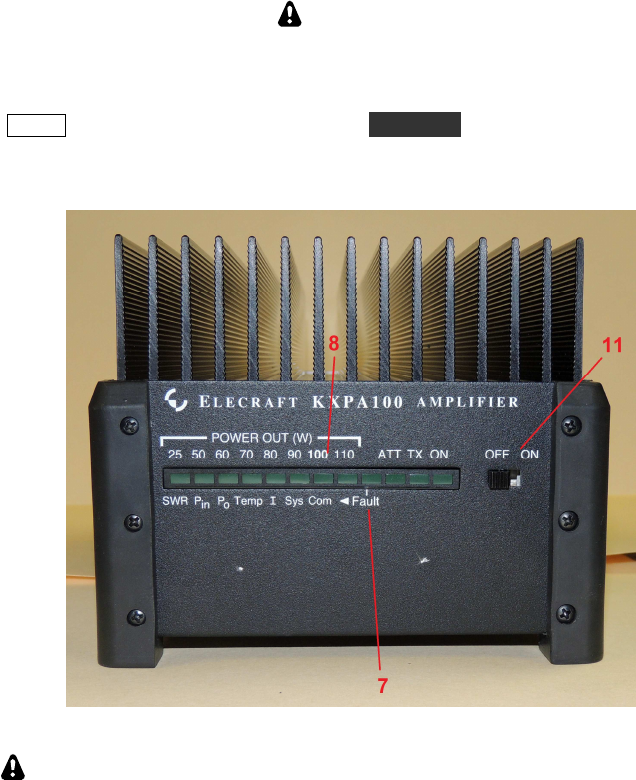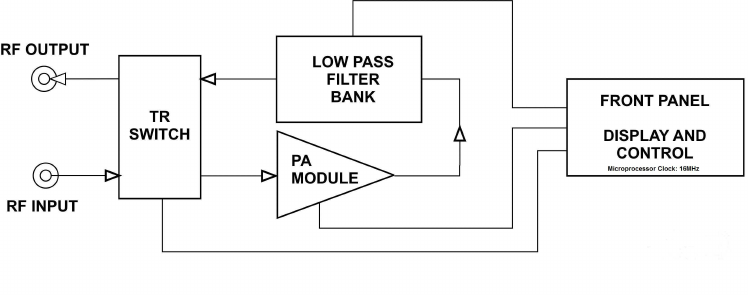Elecraft KXPA100 Amateur Radio External Linear Amplifier User Manual KXPA100 Owner s man FCC prelim
Elecraft, Inc. Amateur Radio External Linear Amplifier KXPA100 Owner s man FCC prelim
Elecraft >
Users Manual

E
LECRAFT
KXPA100
100-W
ATT
A
MPLIFIER
O
WNER
’
S
M
ANUAL
Draft, June 3, 2013
Copyright © 2013, Elecraft, Inc.
All Rights Reserved
2
Contents
Key to Symbols and Text Styles ............................................................................................................... 3
Installation ................................................................................................................................................ 4
Operation .................................................................................................................................................. 6
Power On ..................................................................................................................................................... 6
Band Switching ............................................................................................................................................ 7
Transmitting ................................................................................................................................................. 7
Monitoring ................................................................................................................................................... 8
Fault Conditions ........................................................................................................................................... 8
Firmware Updates ..................................................................................................................................... 9
Specifications .......................................................................................................................................... 10
Customer Service and Support ............................................................................................................... 11
Theory of Operation ............................................................................................................................... 12

3
Key to Symbols Abbreviations and Text Styles
Important – read carefully
Operating tip
TEMP
Tap switch function (labeled above a switch)
PK HOLD
Hold switch function (labeled below a switch; hold for 1/2 sec. to activate)
LED
Light Emitting Diode

4
Installation
The KXPA100 is designed for installation in either a home station or mobile environment.
Two important mounting criteria must be observed. The heat sink fins must be oriented vertically to optimize
natural convection air currents and the power cable run must be as direct as possible.
There are three recommended mounting positions: base down flat, with the heat sink horizontal and fins
pointing up; front panel down, with the fins vertical; and rear panel down with the heat sink fins vertical. Do not
place other equipment, papers, etc., on top of the KXPA100. Keep the KXPA100 out of direct sunlight if
possible.
The KXPA100 draws as much as 24 A of power supply current. The power cable should be as short and direct
as possible to minimize voltage drop. The red power lead connects to positive (+) 13.8V and the black lead
connects to the negative terminal. The negative terminal is common to chassis ground. If the supplied cable is
not long enough, make a cable using no smaller than #10 AWG conductors. For mobile installations, connect the
power cable directly to the battery terminals.
The following text uses braces to refer to numbered elements in the front- and rear-panel illustrations below. For
example, {14} refers to 14, the
RF OUTPUT
connector.
Figure 1. KXPA100 Rear Panel
5
Cabling
1. Connect your station ground to the
GND
thumbscrew {23}. A good station ground is important for
safety and to minimize local radio frequency interference (RFI).
2. Attach the
RF INPUT
{24} to the output of your driving transceiver or transmitter using a 50 ohm
coaxial cable with an PL-259 male connector on the KXPA100 end. The driving transmitter must supply
up to 5 watts for full output from the KXPA100.
3. Attach the
RF OUTPUT {14}
to a suitable load with an SWR of less than 1.5:1. A dummy load is
strongly recommended for initial testing.
4.
Connect the PA KEY
{19} to the driving transmitter Key Output. This line must be grounded to
transmit, and 1 mA of current is sourced. The KXPA100 PA KEY jack is pulled up to 5VDC when not
transmitting.
5. Optional:
RS232 (PC)
{21} connects the KXPA100 to your personal computer with a Elecraft KXUSB
adapter cable. Required for updating the KXPA100 firmware.
6. IMPORTANT: Position the amplifier so the cooling fins may take advantage of natural convection.
Three positions are recommended: base down with the fins pointing up, Front down, with the heat sink
fins vertical, or Rear panel down with the heat sink fins oriented vertically. Ensure that there is at least 2
inches (5 cm) clearance above the amplifier for proper air flow.

6
Operation
Power On
1. Ensure a suitable 50 ohm load is attached to the
ANT 1
connector on the rear panel (Figure 1,
{14}). A dummy load is strongly recommended for initial tests.
2. Enable the power supply by sliding the front panel switch (Figure 2, {11}) to the On (I) position.
The
POWER
LED should light.
IMPORTANT
Switches with a legend above and below the pushbutton have two functions. Tap
(press briefly) to activate the function labeled above a switch. Hold to activate the
function labeled below the switch. In the text, tap functions are shown like this:
TEMP
. An example of a hold function is
PK HOLD
.
Figure 2. KXPA100 Front Panel.
NOTE: If at any time the
FAULT
LED {7} lights, refer to Fault Conditions, pg. 8.

7
Band Switching
The KXPA100 automatically measures the frequency of the RF drive and selects the proper band.
The
PA KEY
input must be connected to the driving transmitter.
Important: The automatic band selection function is active whenever PA KEY is low (in transmit
mode) and overrides band selection made by any other means to protect the KXPA100 from damage
by wrong-band operation.
Transmitting
1. Apply a watt of RF drive and note that the
POWER (W)
LEDs {8} illuminate to indicate the RF
output power.
2. Increase the drive power and confirm that the
SWR
LEDs indicate less than 1.5 while the output
indicated by the
POWER (W)
LEDs increases. Up to 5 watts of drive is required to produce the
full 100 watts output from the KXPA100. If more than 5 watts is applied, enable the input
attenuator (3 dB ATTEN) {17} by sliding its switch to the ON position.
Important: Never exceed 10 watts of drive to the KXPA100 at any time.

8
Monitoring
KXPA100 operation is monitored by the LEDs.
LEDs
Standing wave ratio (SWR) of the load and output power are displayed on LED bar graphs. Excessive levels
may trigger a fault and either bypass the KXPA100 or shut the power off (see Fault Conditions below). Also
two green LEDs indicate whether the amplifier is in standby (STBY) or operating (OPER) mode.
Fault Conditions
The
FAULT
indicator {7} lights to indicate a fault condition has occurred and the KXPA100 is automatically
switched to standby mode.
Low Level Faults
If the
FAULT
indicator is blinking, one of the following low level faults has occurred and will clear
automatically when the condition is corrected.
Fault Cause/Correction
Over Drive RF Drive > 6 Watts (12W if the Attenuator is enabled) / Reduce RF drive to the
KXPA100
Over Output Excessive RF Output / Reduce RF Drive to KXPA100.
High Reflected Power Reflected Power > 20 Watts
Invalid Frequency Frequency counter detected transmissions in a restricted frequency band. Amp
is automatically bypassed until the counter detects this error has been corrected.
High Level Faults
If the indicator is on steady, one of the following high-level faults has occurred and the KXPA100 has
automatically switch to
STBY
mode. Clear the fault, then tap the OPR/STBY switch to resume operation.
Fault Cause/Correction
Over Drive RF Drive > 6 Watts over a period of time, or over 15 Watts momentarily. /
Reduce RF drive to the KXPA100
Over Temp Power Amp Heat Sink > 90°C / Check to ensure heat sink fins are oriented
vertically and are clear of obstructions.
Over Current Excessive Current to Power Amplifier / Check and reduce SWR.
High Reflected Power Reflected power > 20W for an extended period of time or > 30W momentarily.
Open Load Indicated SWR > 18:1
Over Dissipation Finals are dissipating more than 120W of heat
9
Firmware Updates
New features and improvements are available to all KXPA100 owners via firmware upgrades
Please visit the Elecraft Software page (www.elecraft.com) to obtain our free firmware download application,
KXPA100 Utility. Versions of the Utility program are provided for PCs, Macs, and Linux platforms.
If you don’t have Internet access, you can obtain a firmware upgrade on CD. If you don't have a computer, you
can send your KXPA100 to Elecraft to be upgraded. See Customer Service, pg.11.
10
Specifications
Frequency Range All Amateur Bands from 1.8 to 29.7 MHz and 50 to 54 MHz
Supply Voltage and
Current
12-15V DC (13.8V Nominal), 24A (17A Nominal)
Weight 4 lbs
Size Enclosure only, 4.0 x 10.7 x 10.0 in., HWD (10.2 x 27.2 x 25.4 cm). With projections,
4.4 x 11.1 x 11.8 in. (11.2 x 28.2 x 30.0 cm)
Power Output 100 watts
Duty Cycle at 100 Watts 10 minutes key down / 5 minutes off
Drive Power 4 watts for 100 watts output
Input VSWR Less than 1.5:1
SWR TBD
Heat Sink Temperature 90°C, maximum
Key In +5V open circuit on receive, closed to ground on transmit (1 mA max.)
Efficiency Approximately 50%

11
Customer Service and Support
Technical Assistance
You can send e-mail to k3support@elecraft.com and we will respond quickly – typically the same day
Monday through Friday. If you need replacement parts, send an e-mail to parts@elecraft.com. Telephone
assistance is available from 9 A.M. to 5 P.M. Pacific time (weekdays only) at 831-763-4211. Please use e-mail
rather than calling when possible since this gives us a written record of the details of your problem and allows us
to handle a larger number of requests each day.
Repair / Alignment Service
If necessary, you may return your Elecraft product to us for repair or alignment. (Note: We offer unlimited email
and phone support, so please try that route first as we can usually help you find the problem quickly.)
IMPORTANT: You must contact Elecraft before mailing your product to obtain authorization for the
return, what address to ship it to and current information on repair fees and turn around times. (Frequently we
can determine the cause of your problem and save you the trouble of shipping it back to us.) Our repair location
is different from our factory location in Aptos. We will give you the address to ship your kit to at the time of
repair authorization. Packages shipped to Aptos without authorization will incur an additional shipping charge
for reshipment from Aptos to our repair depot
.
Elecraft 1-Year Limited Warranty
This warranty is effective as of the date of first consumer purchase (or if shipped from the factory, the date the
product is shipped to the customer). It covers both our kits and fully assembled products. For kits, before requesting
warranty service, you should fully complete the assembly, carefully following all instructions in the manual.
Who is covered: This warranty covers the original owner of the Elecraft product as disclosed to Elecraft at the time
of order. Elecraft products transferred by the purchaser to a third party, either by sale, gift, or other method, who is
not disclosed to Elecraft at the time of original order, are not covered by this warranty. If the Elecraft product is being
bought indirectly for a third party, the third party’s name and address must be provided at time of order to ensure
warranty coverage.
What is covered: During the first year after date of purchase, Elecraft will replace defective or missing parts free of
charge (post-paid). We will also correct any malfunction to kits or assembled units caused by defective parts and
materials. Purchaser pays inbound shipping to us for warranty repair; we pay shipping to return the repaired
equipment to you by UPS ground service or equivalent to the continental USA and Canada. For Alaska, Hawaii, and
other destinations outside the U.S. and Canada, actual return shipping cost is paid by the owner.
What is not covered: This warranty does not cover correction of kit assembly errors. It also does not cover
misalignment; repair of damage caused by misuse, negligence, or builder modifications; or any performance
malfunctions involving non-Elecraft accessory equipment. The use of acid-core solder, water-soluble flux solder, or
any corrosive or conductive flux or solvent will void this warranty in its entirety. Also not covered is reimbursement
for loss of use, inconvenience, customer assembly or alignment time, or cost of unauthorized service.
Limitation of incidental or consequential damages: This warranty does not extend to non-Elecraft equipment or
components used in conjunction with our products. Any such repair or replacement is the responsibility of the
customer. Elecraft will not be liable for any special, indirect, incidental or consequential damages, including but not
limited to any loss of business or profits.

12
Theory of Operation
When the KXPA100 is in Operating (OPER) mode, RF is routed by the Transmit-Receive (TR) switch to the
Power Amplifier (PA) module where it is amplified by a pair of RD100HHF1 power MOSFETs.
The PA module output is routed to the Low Pass Filter (LPF) bank input. The LPF bank provides separate filters
for each frequency band. The frequency of the incoming signal is monitored and the appropriate filter is
automatically switched into the signal path.
The output of the LPF bank is routed to the RF Output via the TR Switch.
During receive or when the KXPA100 is in Standby (STBY), the TR switch routes the RF Input directly to the
RF Output, bypassing both the PA Module and the Low Pass Filter Bank.
The MCU in the Display and Control module monitors and makes critical measurements of a number of
operating conditions including two levels of fault conditions that automatically alter the operation of the
KXPA100:
1. If an undesirable, but not critical, fault conditions occurs, a 3 dB attenuator is switched in line with the
PA input and the FAULT LED is blinked at a 1 Hz rate to alert the operator. An example of such a fault
is overdriving the KXPA100 input. When the fault is corrected, such as reducing the driving power, the
3 dB attenuator is switched out automatically and FAULT light stops blinking.
2. If a critical fault occurs, the amplifier is automatically switched to STANDBY, passing the RF drive
directly through to the RF Output. The FAULT LED is illuminated continuously.
13
KIT ASSEMBLY PROCEDURE
TBD